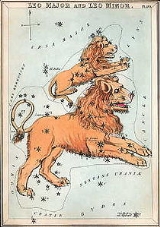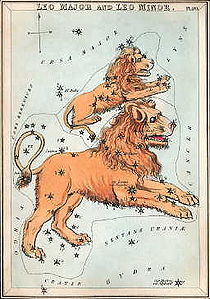
Leo Minor
Encyclopedia
Leo Minor is a small and faint constellation
. Its name means "the smaller lion", in contrast to Leo
, the larger lion. Its brightest stars form a rough triangle, and it lies between the larger and more recognizable Ursa Major
and Leo. Leo Minor was not regarded as a separate constellation by the ancients; it was created by Johannes Hevelius
in 1687.
 Leo Minor contains little to see with small telescopes.
Leo Minor contains little to see with small telescopes.
brighter than fourth magnitude.
The mysterious deep sky object known as Hanny's Voorwerp
was discovered here in 2007 by Dutch school teacher Hanny van Arkel while participating as a volunteer in the Galaxy Zoo
project.
Constellation
In modern astronomy, a constellation is an internationally defined area of the celestial sphere. These areas are grouped around asterisms, patterns formed by prominent stars within apparent proximity to one another on Earth's night sky....
. Its name means "the smaller lion", in contrast to Leo
Leo (constellation)
Leo is one of the constellations of the zodiac. Its name is Latin for lion. Its symbol is . Leo lies between dim Cancer to the west and Virgo to the east.-Stars:...
, the larger lion. Its brightest stars form a rough triangle, and it lies between the larger and more recognizable Ursa Major
Ursa Major
Ursa Major , also known as the Great Bear, is a constellation visible throughout the year in most of the northern hemisphere. It can best be seen in April...
and Leo. Leo Minor was not regarded as a separate constellation by the ancients; it was created by Johannes Hevelius
Johannes Hevelius
Johannes Hevelius Some sources refer to Hevelius as Polish:Some sources refer to Hevelius as German:*Encyplopedia Britannica * of the Royal Society was a councilor and mayor of Danzig , Pomeranian Voivodeship, in the Polish-Lithuanian Commonwealth...
in 1687.
Notable features

Stars
There is only one starStar
A star is a massive, luminous sphere of plasma held together by gravity. At the end of its lifetime, a star can also contain a proportion of degenerate matter. The nearest star to Earth is the Sun, which is the source of most of the energy on Earth...
brighter than fourth magnitude.
- 46 LMi46 Leonis Minoris46 Leonis Minoris is the brightest star in the constellation Leo Minor. It is sometimes known as "o LMi" , from Bode's catalogue of 1801...
(Praecipua): an almost (but not quite) giant starGiant starA giant star is a star with substantially larger radius and luminosity than a main sequence star of the same surface temperature. Typically, giant stars have radii between 10 and 100 solar radii and luminosities between 10 and 1,000 times that of the Sun. Stars still more luminous than giants are...
of spectral classStellar classificationIn astronomy, stellar classification is a classification of stars based on their spectral characteristics. The spectral class of a star is a designated class of a star describing the ionization of its chromosphere, what atomic excitations are most prominent in the light, giving an objective measure...
K0 which lies at a distance of approximately 98 light years and sports an apparent brightnessApparent magnitudeThe apparent magnitude of a celestial body is a measure of its brightness as seen by an observer on Earth, adjusted to the value it would have in the absence of the atmosphere...
of 3.83. Praecipua does not have a Bayer designationBayer designationA Bayer designation is a stellar designation in which a specific star is identified by a Greek letter, followed by the genitive form of its parent constellation's Latin name...
, making Leo Minor the only constellation whose brightest star does not have one. - β LMiBeta Leonis MinorisBeta Leonis Minoris is a binary star in the constellation of Leo Minor. It has an overall apparent visual magnitude of approximately 4.215...
: strangely enough this giant star of spectral class G8 is the only star with a Bayer designation, and with its apparent magnitude of 4.21 it is not even the brightest star of Leo Minor. - R LMi: this cool long-period variable starVariable starA star is classified as variable if its apparent magnitude as seen from Earth changes over time, whether the changes are due to variations in the star's actual luminosity, or to variations in the amount of the star's light that is blocked from reaching Earth...
(a Mira variableMira variableMira variables , named after the star Mira, are a class of pulsating variable stars characterized by very red colors, pulsation periods longer than 100 days, and light amplitudes greater than one magnitude in infrared and 2.5 magnitude in visual...
) varies between magnitudes 6.3 and 13.2 during a period of 372.19 days. - 20 LMi20 Leonis Minoris20 Leonis Minoris is a binary star system in the constellation Leo Minor. It has a relatively high proper motion. The companion is an old, active red dwarf star that has a relatively high metallicity. The two stars are currently separated by 14.5 arc seconds....
: this binary starBinary starA binary star is a star system consisting of two stars orbiting around their common center of mass. The brighter star is called the primary and the other is its companion star, comes, or secondary...
system is only 14.9 parsecParsecThe parsec is a unit of length used in astronomy. It is about 3.26 light-years, or just under 31 trillion kilometres ....
s away from the Sun.
Deep sky objects
The brightest deep sky object in Leo Minor is NGC 3003, a galaxy with an apparent brightness of 11.7m and an angular size of 5.9 arcminutes. It is seen almost edge-on.The mysterious deep sky object known as Hanny's Voorwerp
Hanny's Voorwerp
' , Dutch for Hanny's object, is an astronomical object of unknown nature. It was discovered in 2007 by Dutch school teacher Hanny van Arkel, while she was participating as an amateur volunteer in the Galaxy Zoo project...
was discovered here in 2007 by Dutch school teacher Hanny van Arkel while participating as a volunteer in the Galaxy Zoo
Galaxy Zoo
Galaxy Zoo is an online astronomy project which invites members of the public to assist in the morphological classification of large numbers of galaxies. It is an example of citizen science as it enlists the help of members of the public to help in scientific research. An improved version—Galaxy...
project.

